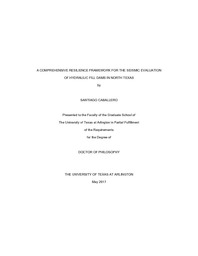
ATTENTION: The works hosted here are being migrated to a new repository that will consolidate resources, improve discoverability, and better show UTA's research impact on the global community. We will update authors as the migration progresses. Please see MavMatrix for more information.
Show simple item record
| dc.contributor.advisor | Puppala, Anand | |
| dc.creator | Caballero, Santiago R | |
| dc.date.accessioned | 2017-07-05T15:51:51Z | |
| dc.date.available | 2017-07-05T15:51:51Z | |
| dc.date.created | 2017-05 | |
| dc.date.submitted | May 2017 | |
| dc.identifier.uri | http://hdl.handle.net/10106/26855 | |
| dc.description.abstract | Hydraulic filling is a construction procedure that was used for earthen structures during the mid-1800s to the early 1900s; however, dams and levees that were constructed by implementing this technique had a significant potential for geotechnical hazards. Historically, most of the failures of these structures were a result of the soil cyclic liquefaction phenomenon. This phenomenon occurs when excess pore water pressure develops during cyclic loading and causes loss of effective strength in the soil. The cyclic stress approach is one of the methods widely used to assess cyclic liquefaction; however, seismic parameters (loading conditions) and soil characterization (liquefaction resistance) must be characterized in a discreet and careful manner. The seismic resilience of hydraulic fill dams depend upon two main contributing factors which are the high variability of soil properties and the sudden increase of seismic activity in areas believed to have low seismicity (magnitude, location, and distance at which the earthquake occurs). Current slope stability and liquefaction analysis considers averaging the soil properties at a specific depth; they are considered as layered systems. However, such analysis is not suitable for hydraulic fill structures due to the high variability of the soil layers and the fact that failure can be triggered at any location within the structure. Hence, a more rigorous approach is required for addressing the variability in soil properties and identifying potential liquefiable layers.
In this research study, a comprehensive seismic resilience framework for hydraulic fill dams was developed based on an enhanced soil characterization and 3D-visualization modeling using in-situ cone penetration testing and geotechnical borehole data. Eagle Mountain Dam located in Fort Worth, Texas was used for the present analysis. Geostatistics was used for modeling of the dam embankment section and these results are then used to assess liquefaction of dam embankment layers. Both deterministic and probabilistic hazard analyses using the recent earthquakes surrounding the test site are performed. Hypothetical scenarios based on source of seismicity, site-to-source distance, and focal depth of earthquakes were also assumed and analyzed. The cyclic liquefaction analysis showed that both deterministic and probabilistic analyses did not cause liquefaction of the layers in the current and natural field conditions. However, probabilistic analyses showed potential liquefaction of layers with an increase in the water elevations within the dam. This study can also be applied and used to evaluate liquefaction of similar structures where seismic activity has been either noted or expected. | |
| dc.format.mimetype | application/pdf | |
| dc.language.iso | en_US | |
| dc.subject | Induced seismicity | |
| dc.subject | Hydraulic fill dams | |
| dc.subject | Cyclic liquefaction | |
| dc.subject | Geotechnical visualization | |
| dc.subject | Geostatistics | |
| dc.title | A COMPREHENSIVE RESILIENCE FRAMEWORK FOR THE SEISMIC EVALUATION OF HYDRAULIC FILL DAMS IN NORTH TEXAS | |
| dc.type | Thesis | |
| dc.degree.department | Civil Engineering | |
| dc.degree.name | Doctor of Philosophy in Civil Engineering | |
| dc.date.updated | 2017-07-05T15:51:51Z | |
| thesis.degree.department | Civil Engineering | |
| thesis.degree.grantor | The University of Texas at Arlington | |
| thesis.degree.level | Doctoral | |
| thesis.degree.name | Doctor of Philosophy in Civil Engineering | |
| dc.type.material | text | |
| dc.creator.orcid | 0000-0003-3498-1102 | |
| local.embargo.terms | 2017-11-01 | |
| local.embargo.lift | 2017-11-01 | |
Files in this item
- Name:
- CABALLERO-DISSERTATION-2017.pdf
- Size:
- 97.97Mb
- Format:
- PDF
This item appears in the following Collection(s)
Show simple item record


